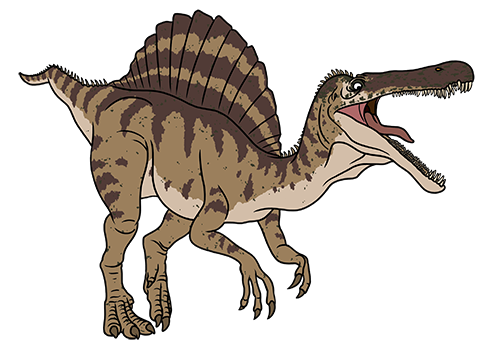Spinosaurus
#3
by Kyle Morris on October 27, 2021The “spine lizard” gets its name from the large sail on its back. Originally discovered in western Egypt in the early 20th century, Ernst Stromer officially named it in 1915. Since then, partial remains of this species have been found throughout northern Africa, most notably in Egypt.
Unfortunately, the museum in Germany that housed the original fossils was destroyed during an Allied bombing in 1944, and the fossils along with it. This left only a few drawings of the original skeleton.

Artist Rendering of Spinosaurus
Before we go any further, it is important to note that paleontologists do not fully agree on the posture of Spinosaurus. For decades it was thought to have walked upright like other theropods. Recently, however, more of its skeleton has been found, which may suggest that it walked on all fours. Or it may have used both forms of locomotion, switching between the two.
This impressive member of the spinosaur kind stood around 15–16 feet tall. It reached lengths of 50 feet, and weight estimates place it at seven or more tons. These measurements make Spinosaurus the largest land carnivore to ever exist.
The animal’s large sail was likely used to attract a mate and to help them recognize each other. It may also have been used to help the Spinosaurus thermoregulate (warm up or cool down). Aside from its size and sail, another unique feature of this dinosaur is its tail. The caudal or “tail” vertebrae were unusually tall. This gave its tail a paddle-like appearance, which likely aided in swimming and allowed it to hunt in water effectively.
The Spinosaurus became famous after its appearance in 2001’s Jurassic Park III. In this film, it replaced the T.rex as the main large theropod. It did so by fighting and ultimately killing a T.rex before chasing the human characters throughout the rest of the movie. It is worth noting that the T.rex was a sub-adult (not fully grown). In reality, the Spinosaurus’ crocodilian-like jaw wasn’t built for fighting other large theropods. God designed its jaws in such a way that made it great for catching fish, just like its smaller cousins Baryonyx and Suchomimus.
October is “dinosaur month!” Every weekday of this month, you can come back to our Kids site to read about my 20 favorite dinosaurs. I hope you’ll join me!
- © 2025 Answers in Genesis
- Privacy Policy
- Contact
- About
